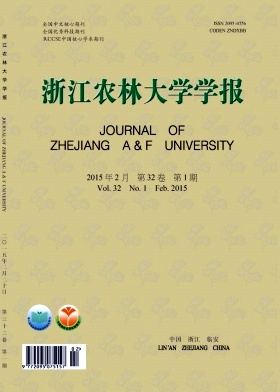| [1] |
SHEN Yi, QI Mengwen, YANG Guiying, ZHOU Qihuan, YU Ting, LI Wuhan, MO Jianchu.
Biodegradation of rice straw by symbiotic fungi of Odontotermes formosanus
. Journal of Zhejiang A&F University,
2023, 40(6): 1224-1231.
doi: 10.11833/j.issn.2095-0756.20230140
|
| [2] |
SUN Haiyan, WANG Yurong.
Formation, characterization and change of ultrastructure in wood cell wall
. Journal of Zhejiang A&F University,
2019, 36(2): 386-393.
doi: 10.11833/j.issn.2095-0756.2019.02.021
|
| [3] |
XUE Ziqiao, WANG Xuehua, ZHOU Yaqin, CHEN Mengqi, HUANG Qiongtao.
Physical and mechanical properties of low thermo-vacuum treated wood
. Journal of Zhejiang A&F University,
2019, 36(1): 177-182.
doi: 10.11833/j.issn.2095-0756.2019.01.022
|
| [4] |
LI Weiguang, ZHANG Zhankuan.
Modeling the cutting force in wood sawing with different radial clearance angles based on a response surface methodology
. Journal of Zhejiang A&F University,
2018, 35(3): 524-528.
doi: 10.11833/j.issn.2095-0756.2018.03.018
|
| [5] |
YU Youming, WANG Cong, CAI Zhiyong, LU Keyang.
Bending performance of wood-aluminum composites: prediction and analysis
. Journal of Zhejiang A&F University,
2017, 34(1): 1-6.
doi: 10.11833/j.issn.2095-0756.2017.01.001
|
| [6] |
HU Mengxiao, HANG Yun, HUANG Huahong, ZHANG Shenglong, TONG Zaikang, LOU Xiongzhen.
A near infrared prediction model and variation analysis of wood crystallinity in Cunninghamia lanceolata
. Journal of Zhejiang A&F University,
2017, 34(2): 361-368.
doi: 10.11833/j.issn.2095-0756.2017.02.022
|
| [7] |
FANG Yiming, LIN Lujun, LU Zhixiong, FENG Hailin.
An air-coupled ultrasonic imaging system for non-destructive wood testing
. Journal of Zhejiang A&F University,
2017, 34(2): 355-360.
doi: 10.11833/j.issn.2095-0756.2017.02.021
|
| [8] |
NI Qianqian, QI Hengnian, ZHOU Zhu, WANG Hangjun.
Identifying Dalbergia spp. wood with hyperspectral imaging technology
. Journal of Zhejiang A&F University,
2016, 33(3): 489-494.
doi: 10.11833/j.issn.2095-0756.2016.03.017
|
| [9] |
WANG Zhe, SUN Bailing, LIU Junliang, CHAI Yubo, CAO Jinzhen.
Chemical property changes of vacuum heat-treated Larix kaempferi wood
. Journal of Zhejiang A&F University,
2016, 33(6): 1052-1057.
doi: 10.11833/j.issn.2095-0756.2016.06.018
|
| [10] |
GAO Shan, WANG Lihai, YANG Donghui, XU Wenhao.
Probe-wood contact and gauge pressure with Sylvatest-Duo for precision ultrasonic measurements of wood
. Journal of Zhejiang A&F University,
2016, 33(5): 875-880.
doi: 10.11833/j.issn.2095-0756.2016.05.021
|
| [11] |
FU Xiaoping, YAO Shanshan, WANG Ying, GUO Ming.
Preparation and performance of novel immobilized cellulase
. Journal of Zhejiang A&F University,
2016, 33(2): 315-321.
doi: 10.11833/j.issn.2095-0756.2016.02.018
|
| [12] |
XIE Linkun, WANG Hongyan, GUAN Cheng, DU Guanben.
Silylated Pinus kesiya and Betula alnoides wood surfaces using hexamethyldisiloxane (HMDSO) plasma deposition
. Journal of Zhejiang A&F University,
2015, 32(6): 903-908.
doi: 10.11833/j.issn.2095-0756.2015.06.012
|
| [13] |
ZHANG Lei, CHANG Xiaoya, WU Jing, WANG Mingzhi.
Fire-retardant properties of an intumescent fire retardant coating for wood using 4A zeolite
. Journal of Zhejiang A&F University,
2015, 32(1): 156-161.
doi: 10.11833/j.issn.2095-0756.2015.01.023
|
| [14] |
ZHOU Zhu, FANG Yiming, YIN Jianxin, ZHOU Suyin, LUO Ruisen, ZHENG Jian.
Review of nondestructive detection of wood and wood products based on hyperspectral imaging technology
. Journal of Zhejiang A&F University,
2015, 32(3): 458-466.
doi: 10.11833/j.issn.2095-0756.2015.03.020
|
| [15] |
TONG Thi Phuong, MA Zhongqing, CHEN Dengyu, ZHANG Qisheng.
Pyrolysis characteristics and kinetics study of bamboo holo-celluloce using TG-FTIR
. Journal of Zhejiang A&F University,
2014, 31(4): 495-501.
doi: 10.11833/j.issn.2095-0756.2014.04.001
|
| [16] |
GUO Dongqiang, YE Lu, ZHOU Wei, LIU Yuan, CHEN Jianbo, LU Cuixiang, XIANG Dongyun.
Wood fiber features for two provenances of Eucalyptus dunnii
. Journal of Zhejiang A&F University,
2014, 31(4): 502-507.
doi: 10.11833/j.issn.2095-0756.2014.04.002
|
| [17] |
FU Jianguo, LIU Jinliang, YANG Xiaojun, AN Yulin, LUO Jiayan.
DNA extraction and molecular identification of imported Dalbergia wood
. Journal of Zhejiang A&F University,
2013, 30(4): 627-632.
doi: 10.11833/j.issn.2095-0756.2013.04.025
|
| [18] |
BAI Hong-xia, YUAN Xiu-ying.
Survey on the diversity of endophytes in Populus for Inner Mongolia
. Journal of Zhejiang A&F University,
2006, 23(6): 629-635.
|
| [19] |
CHENG Xiao-jian, YANG Ping, LIN Bo-nian, ZHENG Bing-song.
Genetic relationship of myrobalan plum, plum and apricot cultivars by RAPD analysis
. Journal of Zhejiang A&F University,
2004, 21(1): 40-43.
|
| [20] |
Liu Li, Zhou Jianzhong, Yu Shiyuan, Shan Gu..
Enzymatic Hydrolysis and Feed Exploitation of Canned Bamboo Shoot Residues of Phyllostachys prominens.
. Journal of Zhejiang A&F University,
1997, 14(3): 262-266.
|






 DownLoad:
DownLoad: